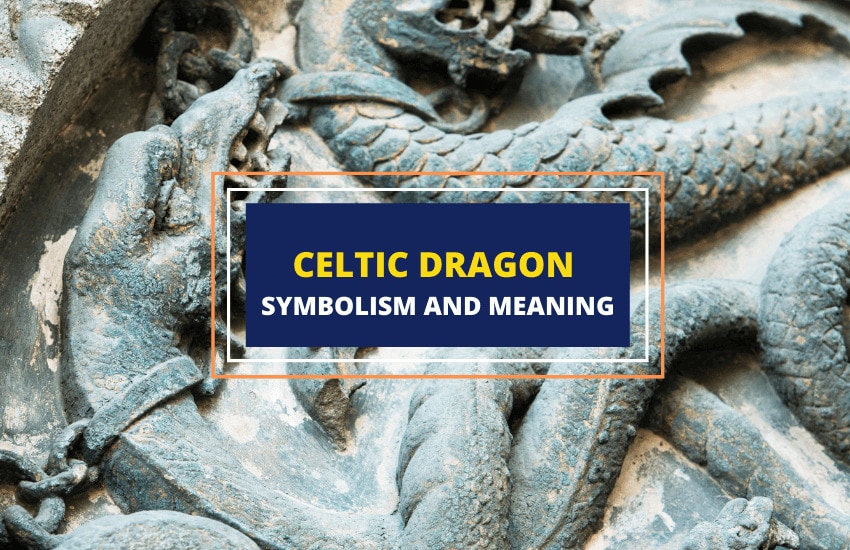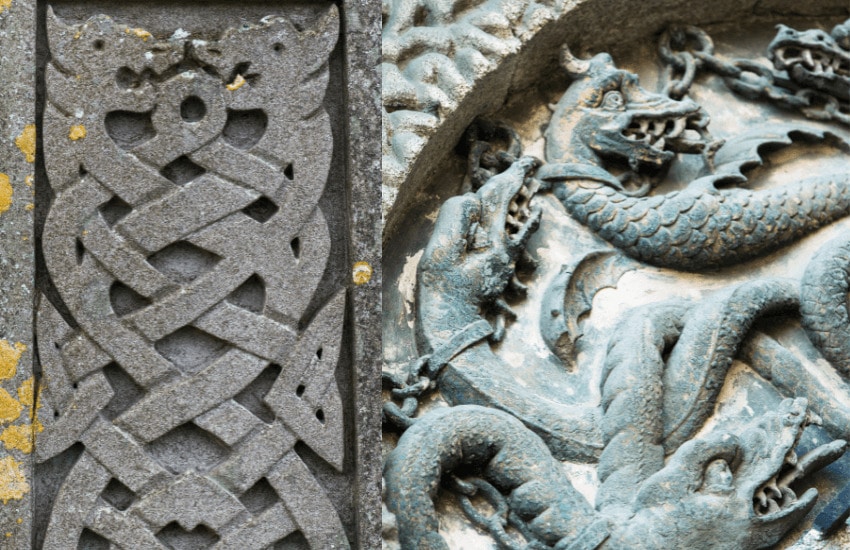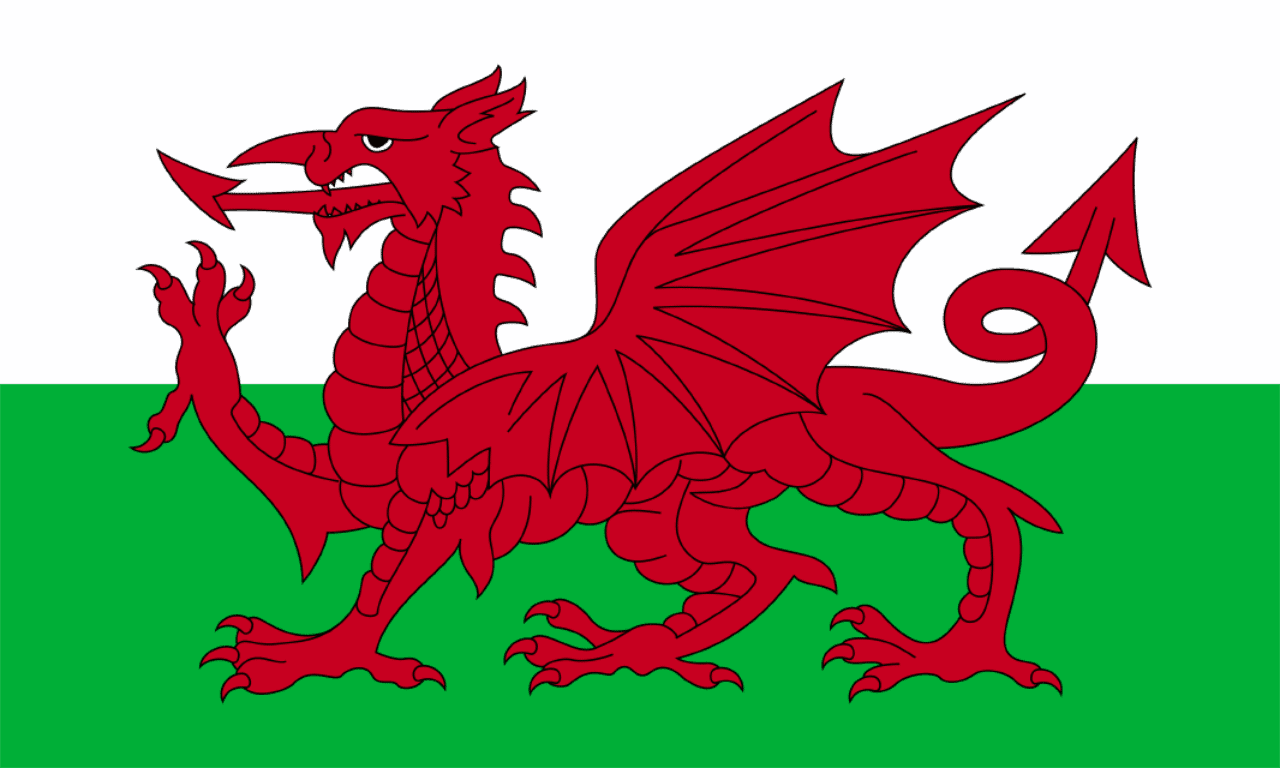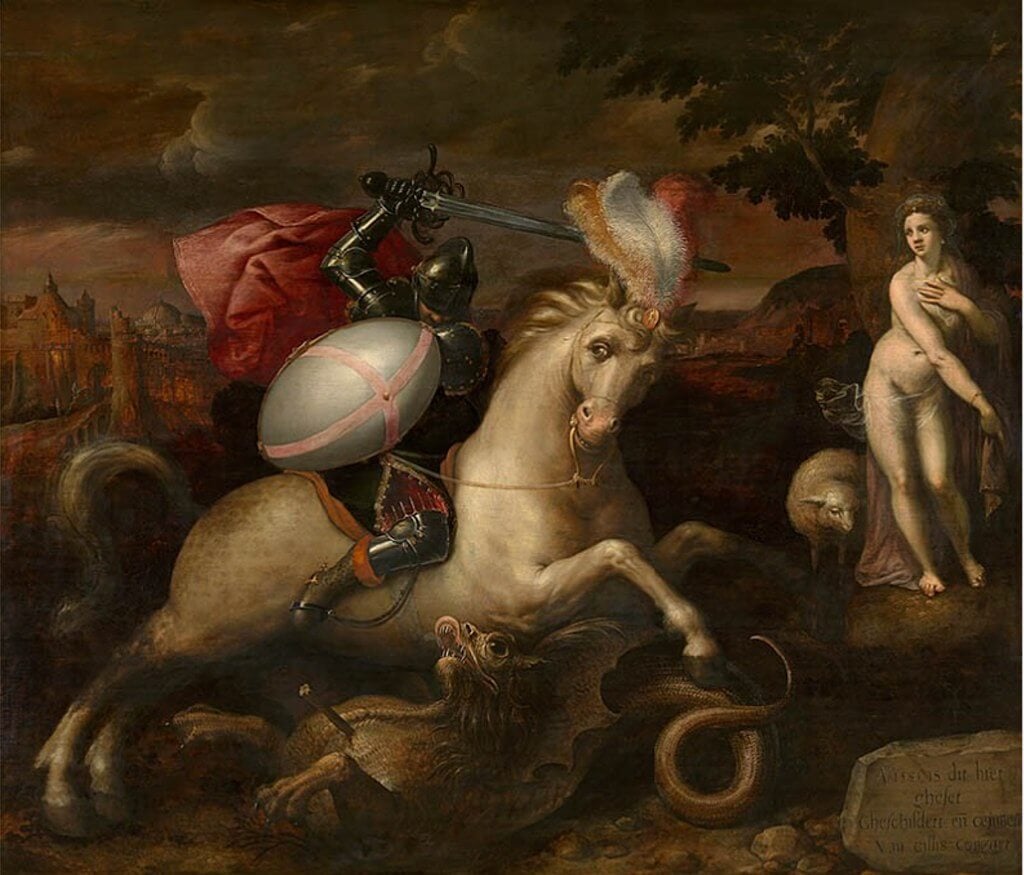
Table of Contents
In Celtic mythology, dragons are powerful symbols, viewed as creatures that protect the earth, stand side by side with the gods, and have great power. They are symbols of fertility, wisdom, leadership, and strength, and images of Celtic dragons can be seen in artwork, architecture, and even today, in flags, logos, and more in the Celtic area.
Here’s a look at the symbolism and importance of the dragon in Celtic culture and mythology.
What Is the Celtic Dragon?

In Celtic lore, there are two main types of dragons:
- Large, winged creatures with four legs
- Large, serpent-like creature with either small wings or no wings, but no legs
Dragons were depicted in numerous ways, but a common portrayal is of dragons with their tails in (or near) their mouths, effectively creating a circle. This was to demonstrate the cyclical nature of the world and life.
The Celts viewed dragons as magical creatures that are often portrayed next to Celtic gods. So powerful were these creatures that it was believed they could affect the lay of the land, and paths where dragons had passed were considered more powerful than others. They were viewed as symbols of power, leadership, wisdom, and fertility.
However, after the advent of Christianity, this positive perception of dragons began to change. Celtic dragons began to be depicted as monsters that needed to be vanquished. They were adapted into legends of Christianity, where they’re portrayed as monsters symbolic of evil that are eventually slain by Christian saints.
Meaning and Symbolism of the Celtic Dragon

While the belief in Celtic dragons hardly exists in the 19th century, they remain symbolic in modern times, especially in present-day Ireland, Scotland, and Wales. Here are some of its meanings:
- Royalty and Power
Dragons have featured in several badges, flags, and other coat of arms in the United Kingdom. An image of a red dragon has been featured on the British royal badge, the king’s badge for Wales, and on the Welsh flag.
- Leadership and Bravery
Among the Celts, the dragon was a symbol of leadership and bravery. The Welsh word for dragon is draig or ddraich, which has been used to refer to great leaders.
In Welsh literature, Arthurian legends used the title Pendragon or Pen Draig, where the Welsh word pen means leader or head, therefore the title means chief dragon or head dragon. In the legend, Pendragon was the name of several kings of the Britons.
In the Vulgate cycle, Aurelius Ambrosius was called Pendragon. The brother of Ambrosius and the father of King Arthur also took the title as Uther Pendragon. As a king, Uther ordered the construction of two gold dragons, one of which was used as his battle standard.
- Symbol of Wisdom
The Celtic dragon’s symbolism of wisdom likely stems from the teachings of traditional Druid orders, as well as from the Merlin legend. In the book The Prophetic Vision of Merlin, dragons symbolize creative energies present within the land and every human being. When these energies awaken, they’re thought to bring magical gifts of wisdom and power.
- Symbol of Fertility
To the Celts, the dragon was a symbol of fertility, and seen as an indicator of the harvests and seasonal fertility. According to the Celts, dragons were conceived from the first living cell on earth. This was fertilized by the sky and nourished by water and winds.
- The Four Elements
In Druid and Celtic mysticism, the dragon is associated with the elements of water, earth, air, and fire. The water dragon is associated with passion, while the earth dragon denotes power and riches. It’s also believed that the air dragon brings insight and clarity to one’s thought and imagination. On the other hand, the fire dragon brings vitality, enthusiasm, and courage.
The Celtic Dragon in Mythology

St. George, St. Patrick, and St. Michael Slaying the Dragons
The patron saint of England, St. George is one of the best-known dragon slayers of Christianity. In The Golden Legend, he saves a Libyan king’s daughter from a dragon. The king shows his gratitude by ordering his subjects to get baptized. St. George is also one of the characters in the 1597 ballad of the Seven Champions of Christendom by Richard Johnson. Similar tales are found throughout European folklore, including Germany, Poland, and Russia.
In Ireland, St. Patrick is depicted as the dragon slayer, who killed the serpent gods Corra and Caoranach. As snakes aren’t common in Ireland, this story has caused much debate. Many scholars speculate that the portrayal of St. George of England and St. Patrick of Ireland killing the dragons are symbols of Christian dominance over Celtic paganism.
In British and Scottish folklore, St. Michael is a mythological hero figure who was recognized for eliminating dragons from the land. In these stories, the dragon represented the pagan influences beaten down by Christianity. In fact, many churches dedicated to St. Michael were built on ancient holy sites, especially the tower at Glastonbury Tor, which also shows that his legends have Celtic roots.
The Lambton Worm
One of the famous dragon stories is about the worm that haunted the region around the Lambton Castle. The term worm was the Saxon and Norse word for dragon. The creature is derived from Scandinavian mythology, which arrived in Celtic lands through the Vikings. It’s described as a dragon figure that resembles a serpent, sometimes an eel or newt.
In the story, a sacrilegious knight went fishing on Sunday morning instead of going to church. Unfortunately, he saw a strange creature, resembling an eel with nine mouths. Frightened, he threw it down a well, and went off to the Crusades. Unfortunately, the worm grew to an enormous size and turned into a monster, ravaging the countryside, and killing all the knights sent to kill it.
The worm was hard to conquer because its breath poisoned the air, and every time it was cut in two, it reassembled itself together and attacked again. When the knight came back from the Holy Land, he found his people in fear. Since he knew it was his fault, he promised to kill the worm. Eventually, he managed to kill the creature with his spiky armor.
In Arthurian Legends
As already mentioned, dragon tales and stories about King Arthur had been popular in Wales, a nation symbolized by a red dragon, before the 11th century. According to legend, King Arthur was the most glorious ruler of the Britons, a group of Celtic people inhabiting Britain before the Anglo-Saxon invasion in the 5th century.
The title of King Arthur’s father, Uther Pendragon, was inspired by a dragon-shaped comet that served as a sign of his accession to the crown. The comet appeared in the sky before the battle with the Saxons, where his brother Aurelius died. As an epithet, Pendragon can be interpreted as Chief of Warriors or Foremost Leader.
Some historians believe that King Arthur was a real warrior who led British armies against Saxon invaders, but no evidence can confirm his existence. In fact, the story was inspired by legends about great leaders like Alexander the Great and Charlemagne, though certain features of Celtic stories were adapted to suit feudal times.
The Celtic Dragon in History

In Religion
The ancient Celts were groups of people living in parts of Europe in the late Bronze Age and through the Iron Age, around 700 BCE to 400 CE. Neither the Romans nor Anglo-Saxons were able to successfully invade the region, so the Celts continued to thrive in northern Britain and Ireland, where Celtic culture continued to flourish into the medieval period.
After the Romans defeated Gaul in 51 BCE, Julius Caesar continued to invade countries surrounding Gaul. In 432 CE, Christianity arrived in Ireland with St. Patrick so many Celtic traditions were incorporated into the new religion.
When Catholicism took over as the dominant religion, old Celtic traditions lived on in their epic tales, including those of dragons and heroes. However, most legends became a combination of Celtic motifs and Christianity. It’s believed that the dragon’s popularity in European legend was a result of biblical associations of it with the arch-figure of diabolical evil.
The English term dragon and the Welsh draig are both derived from the Greek term drakon that means large serpent. In the book of Revelation, the dragon represents Satan the Devil, described as a great fiery-colored dragon with seven heads and ten horns. By the end of the Middle Ages, over 100 saints had been credited with their encounters with diabolical foes in the form of monstrous serpents or dragons.
In Literature
In Historia Brittonum, a compilation dating from the early 9th century, the dragon is mentioned in the story of King Vortigen. The mythical creature has also been featured in the medieval Welsh tale Lludd and Llefelys, which was also included in the History of the Kings of Britain, a popular source of legend about King Arthur.
In Heraldry
The symbolism of the Celtic dragon as an emblem of royalty has continued through the ages. During the 15th century, the dragon was featured on the royal standard of Owain Gwynedd, the king of Wales who fought a war of independence against the English dominance. The standard was called Y Ddraig Aur that translates as The Gold Dragon.
Later, it was introduced into England by the House of Tudor, which was of Welsh origin. In 1485, the Welsh dragon was used by Henry Tudor at the Battle of Bosworth. As a result of his victory, he became Henry VII of England, and displayed the dragon on his coat of arms.
In Brief
The appeal of Celtic legends, especially their tales of dragons and heroes, remains strong in the modern times. The dragon has been an important symbol for the Celts and features in many tales as a symbol of power, fertility, wisdom, and leadership. The image of dragons continues to be seen in architecture, logos, flags, and heraldry in regions that were once the lands of the Celts.








